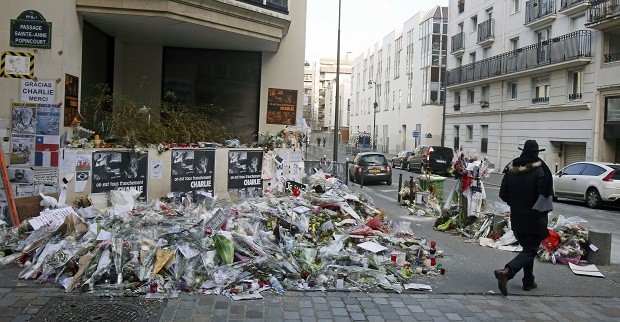
In this Friday Feb. 6, 2015 file photo, a man walks past flowers laid near the headquarters of magazine Charlie Hebdo in Paris. Seventeen people died at Charlie Hebdo on Jan. 7, 2015 and at a kosher supermarket two days later. They were among the first victims of a string of attacks by Islamic fundamentalists in France last year that ultimately left at least 147 people dead and hundreds of others injured. In a special edition marking the anniversary of the Jan. 7 attack on the paper’s staff, Charlie Hebdo’s surviving artists and writers declared that the satirical newspaper is alive, but “the murderer is still at large.” AP FILE PHOTO
PARIS — In a special edition laced with blasphemy, obscenity and profanity, Charlie Hebdo’s surviving artists and writers declared that the satirical newspaper is alive, but “the murderer is still at large.”
The 32-page copy marking the anniversary of the Jan. 7 attack on the paper’s staff accuses Islamic fundamentalists, organized religion, an irresolute government and intelligence failures for the 2015 violence in France by Muslim extremists that started with that day.
Seventeen people died at Charlie Hebdo and at a kosher supermarket two days later. They were among the first victims of a string of attacks by Islamic fundamentalists in France last year that ultimately left at least 147 people dead and hundreds of others injured.
Almost all of those believed directly responsible for the Jan. 7-9 attacks and the Nov. 13 carnage in Paris that killed 130 people are dead as well. But Charlie Hebdo’s special edition this week, with a front-page caricature of a bloody God wielding an assault rifle, darkly predicts that more violence is to come.
READ: Charlie Hebdo now feels abandoned
Laurent Sourisseau, the newspaper’s director who goes by the name Riss, drew the cover and wrote an editorial describing the horror he survived — and that took the lives of friends and colleagues. He described the newsroom’s silence moments after the two gunmen opened fire, saying that was how he knew his colleagues were dead.
Riss wrote that Islamic fanatics and other religious zealots wanted Charlie Hebdo’s secular journalists to pay the ultimate price “for daring to laugh at religion.” He insisted that the newspaper would remain alive because “never have we wanted so much to break the faces of those who dreamed of our deaths.”
The editorial “is violent and very insulting toward religion,” Abdallah Zekri, president of the Observatory against Islamophobia, told BFM television on Monday.
In a separate piece, chief editor Gerard Biard marveled that, although the Charlie Hebdo killings launched a global debate on the role of religion and free speech, no one even bothered to explain to the world why the attackers went after the kosher supermarket.
“We are so used to Jews being killed because they are Jewish,” he wrote. “This is an error, and not just on a human level. Because it’s the executioner who decides who is Jewish. Nov. 13 was the proof of that. On that day, the executioner showed us that he had decided we were all Jewish.”
The edition, on newsstands Wednesday, details the moments of horror in Paris’ 11th arrondissement in the first staff meeting of 2015. The day had started in usual French fashion for the New Year, with kisses on the cheek and well wishes. One staffer went downstairs to fetch her daughter from daycare, and the brothers Said and Cherif Kouachi called out her pen name upon seeing her: “Coco.”
They had already killed the building’s handyman, Frederic Boisseau. With their guns at her back, the staffer opened the door and then the attackers opened fire. It took just minutes to kill 11 people in the building; they would fire point-blank on a Muslim police officer on the way out, his death horrifically immortalized in cell phone video.
READ: 69 journalists died on the job in 2015, report says
Patrick Pelloux, an emergency room doctor and columnist for the newspaper, was among the first to arrive after a call from one of the survivors in the room. “The more I went upstairs, the more blood there was,” Pelloux wrote.
In a series of editorials later in the edition, Charlie Hebdo takes aim at university students who wear veils or openly pray in classrooms, hospital patients who refuse medical treatment from someone of the opposite sex, and France’s intelligence community. Mixed in were blasphemous caricatures targeting a range of beliefs, obscene sketches, and a variety of French profanity that takes standard grade cursing as a mere starting point.
In all, typical Charlie Hebdo, alive and well.